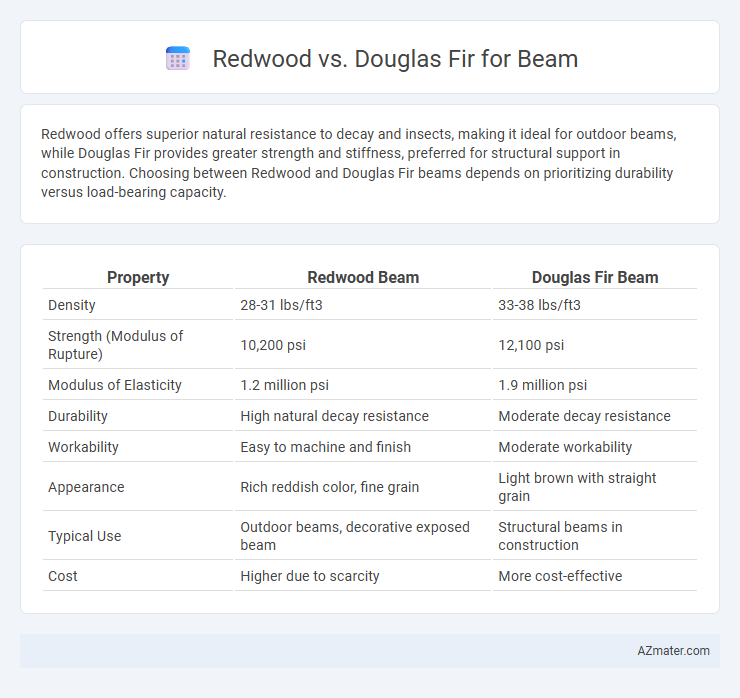Redwood offers superior natural resistance to decay and insects, making it ideal for outdoor beams, while Douglas Fir provides greater strength and stiffness, preferred for structural support in construction. Choosing between Redwood and Douglas Fir beams depends on prioritizing durability versus load-bearing capacity.
Table of Comparison
| Property | Redwood Beam | Douglas Fir Beam |
|---|---|---|
| Density | 28-31 lbs/ft3 | 33-38 lbs/ft3 |
| Strength (Modulus of Rupture) | 10,200 psi | 12,100 psi |
| Modulus of Elasticity | 1.2 million psi | 1.9 million psi |
| Durability | High natural decay resistance | Moderate decay resistance |
| Workability | Easy to machine and finish | Moderate workability |
| Appearance | Rich reddish color, fine grain | Light brown with straight grain |
| Typical Use | Outdoor beams, decorative exposed beam | Structural beams in construction |
| Cost | Higher due to scarcity | More cost-effective |
Introduction to Redwood and Douglas Fir Beams
Redwood beams are valued for their natural durability, resistance to decay, and rich reddish hue, making them ideal for outdoor and architectural applications. Douglas fir beams offer exceptional strength, stiffness, and dimensional stability, commonly used in heavy construction and structural framing. Both woods provide versatile options for beams, with redwood excelling in aesthetics and weather resistance, while Douglas fir boasts superior mechanical properties.
Strength and Structural Performance Comparison
Douglas Fir boasts a higher strength-to-weight ratio than Redwood, making it a preferred choice for structural beams in heavy-load applications. Redwood offers superior natural resistance to decay and insect damage but has lower compressive strength and stiffness compared to Douglas Fir. Engineers often select Douglas Fir for critical load-bearing beams due to its enhanced modulus of elasticity and bending strength.
Durability and Resistance to Decay
Redwood beams exhibit superior natural durability and resistance to decay due to their high tannin content, making them ideal for outdoor and moisture-prone applications. Douglas Fir beams, while strong and structurally reliable, generally require treatment to enhance their decay resistance when exposed to harsh environments. In terms of longevity, untreated Redwood outperforms untreated Douglas Fir, reducing maintenance costs and prolonging structural integrity in beams.
Redwood vs Douglas Fir: Aesthetic Differences
Redwood beams exhibit a rich, reddish-brown hue with natural variations that create a warm and rustic aesthetic, while Douglas Fir beams tend to have a lighter, golden-yellow color with straight, pronounced grain patterns that offer a clean and classic appearance. Redwood's tighter grain and natural color variations make it popular for decorative applications and exposed structures, whereas Douglas Fir's uniform texture and lighter tone suit modern and traditional designs alike. Both woods provide distinct visual appeal, with Redwood often preferred for its striking beauty and Douglas Fir for its versatility and bright finish.
Cost Analysis and Value for Money
Redwood beams typically cost more upfront due to their natural resistance to decay and aesthetic appeal, while Douglas Fir offers a more budget-friendly option with strong structural properties. The value for money between Redwood and Douglas Fir beams hinges on the project's longevity requirements and environmental conditions; Redwood's durability can reduce maintenance expenses over time, potentially offsetting its higher purchase price. For cost-sensitive projects prioritizing strength, Douglas Fir provides solid performance, whereas Redwood delivers enhanced lifespan and visual quality that may justify the premium investment.
Workability and Construction Ease
Redwood offers exceptional workability due to its uniform grain and softness, making it easier to cut, shape, and fasten during beam fabrication. Douglas Fir, while slightly harder and denser, provides superior strength but requires more effort and precision when handling and installing beams in construction. For projects prioritizing ease of machining and installation speed, Redwood proves advantageous, whereas Douglas Fir suits applications demanding higher structural performance despite increased labor.
Sustainability and Environmental Impact
Redwood beams are prized for their natural resistance to decay and insects, reducing the need for chemical treatments and thus lowering environmental impact. Douglas Fir grows faster and is more widely available, making it a more renewable choice, yet its production often involves more energy-intensive processes. Both woods sequester carbon during growth, but sustainably harvested Douglas Fir from certified forests offers a balance between environmental responsibility and structural performance.
Common Applications in Construction
Redwood beams are prized for their natural resistance to decay and insect damage, making them ideal for outdoor structures such as pergolas, decks, and exposed framing where durability is critical. Douglas Fir beams offer superior strength and stability, commonly used in heavy timber framing, roof trusses, and interior support beams due to their high load-bearing capacity. Both woods are valued in construction, but Redwood excels in longevity for exterior use while Douglas Fir is preferred for structural applications requiring robustness.
Maintenance Requirements and Longevity
Redwood beams require less maintenance due to their natural resistance to decay and insect damage, making them ideal for outdoor applications with minimal upkeep. Douglas Fir beams, while strong and widely used, need regular treatment with sealants or preservatives to protect against moisture and pests, increasing maintenance efforts over time. Redwood generally offers greater longevity, often exceeding 30 years outdoors without significant degradation, whereas Douglas Fir's lifespan depends heavily on consistent maintenance practices.
Choosing the Right Wood for Your Project
Redwood offers natural resistance to decay and insects, making it ideal for outdoor beams exposed to harsh weather, while Douglas Fir provides superior strength and stability, preferred for structural applications requiring high load-bearing capacity. Choose Redwood for its durability and attractive grain in visible or decorative beams, and Douglas Fir for its cost-effectiveness and availability in larger dimensional lumber. Assess project needs based on exposure, load requirements, and aesthetic preferences to select the most suitable wood beam.

Infographic: Redwood vs Douglas Fir for Beam
 azmater.com
azmater.com